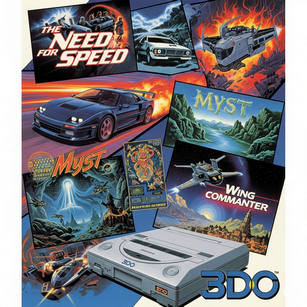Abstract: This article analyzes the Panasonic 3DO Interactive Multiplayer (1993) not as a commercial product, but as a conceptual model for a universal entertainment platform. It examines the reasons for its market failure and traces the legacy of its key ideas. The central thesis is that, despite its failure, the ideological foundations of the 3DO have been realized in modern game engines (Unreal Engine, Unity), and its technological base served as a catalyst for the early development of the field of interactive cinema.
1. Introduction: The Ambition and Architecture of the 3DO In the early 1990s, The 3DO Company, founded by visionary and Electronic Arts creator Trip Hawkins, introduced a radically new business model to the market. Instead of creating a closed ecosystem (like Nintendo or Sega), 3DO developed a set of hardware and software specifications that it licensed to third-party manufacturers. The goal was to create a single, universal standard for interactive entertainment. Technologically, the platform was based on a 32-bit RISC architecture and the CD-ROM optical medium, which opened up unprecedented possibilities. This power enabled the emergence of such landmark titles as the mystical quest “Myst” and the first installment of the legendary series “The Need for Speed,” which demonstrated the platform’s potential for creating both deep narrative worlds and, for its time, advanced 3D graphics.
2. The Legacy of Universalism in Modern Game Engines The 3DO’s core idea—”create once, run on any device”—failed at the hardware level due to its high price and stiff competition from the Sony PlayStation. However, this concept did not disappear; it transformed and found its perfect implementation in modern game engines like Unreal Engine and Unity.
Let’s conduct a comparative analysis:
- 3DO as a Hardware Standard: A developer created a game for the 3DO specification, and it would run on any console that met that specification (Panasonic, Sanyo, Goldstar).
- Game Engines as a Software Standard: A developer creates a game within the engine’s environment, and the engine itself handles the task of compiling and adapting the product for radically different hardware architectures: PC, consoles (PlayStation, Xbox, Nintendo), and mobile platforms.
Thus, the dream of a universal platform was realized at the software level, not the hardware level. Modern engines are the true “Interactive Multiplayers” of today, delivering a unified interactive experience across a multitude of devices, making them the direct ideological successors to the 3DO.
3. Influence on the Development of Interactive Cinema The 3DO platform became one of the most important testing grounds for experiments in the field of interactive cinema. Its contribution can be structured into three areas:
- Technological Enablement: Through the use of CD-ROMs, the 3DO provided developers with enough storage space for hours of digitized video (Full Motion Video, FMV). This removed the technical limitations of cartridges and made video-centric games a commercially viable format.
- Formation and Criticism of the Field: The 3DO became home to iconic, albeit controversial, FMV titles like The 11th Hour, Wing Commander III, and Phantasmagoria. These games demonstrated the potential of player-driven narratives. At the same time, this is where the “paradox of openness” became apparent: the lack of region-locking and robust copy protection, while consumer-friendly, may have deterred publishers from investing in expensive cinematic projects, thus exacerbating a content crisis.
- A Costly Lesson for Future Developers: The failure of many FMV games on the 3DO served as a costly lesson for the industry. It showed that passively watching video is not compelling gameplay. This pushed the next generation of developers to seek deeper forms of interactivity, which ultimately led to the complex choice-and-consequence systems we see in modern interactive dramas.
4. Conclusion The Panasonic 3DO Interactive Multiplayer is a textbook example of a product whose conceptual significance far outweighs its commercial success. As a hardware platform, it failed, but its foundational idea of universalism is now an industry standard, realized through game engines. In the context of interactive cinema, the 3DO acted as a necessary, though flawed, catalyst that technologically enabled the field and, through its shortcomings, pointed the way toward its future development. The dream of a single interactive multimedia device, which the 3DO cherished, lives on today in modern consoles and Smart TVs, making its history critically important for understanding the evolution of modern interactive media.





